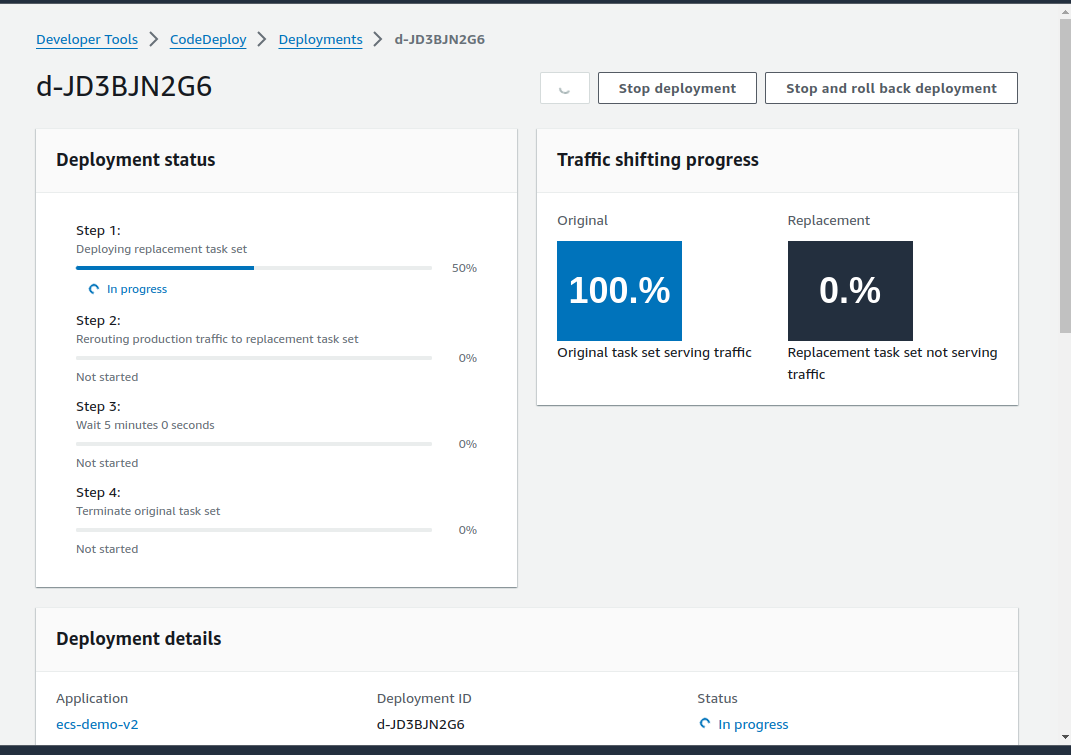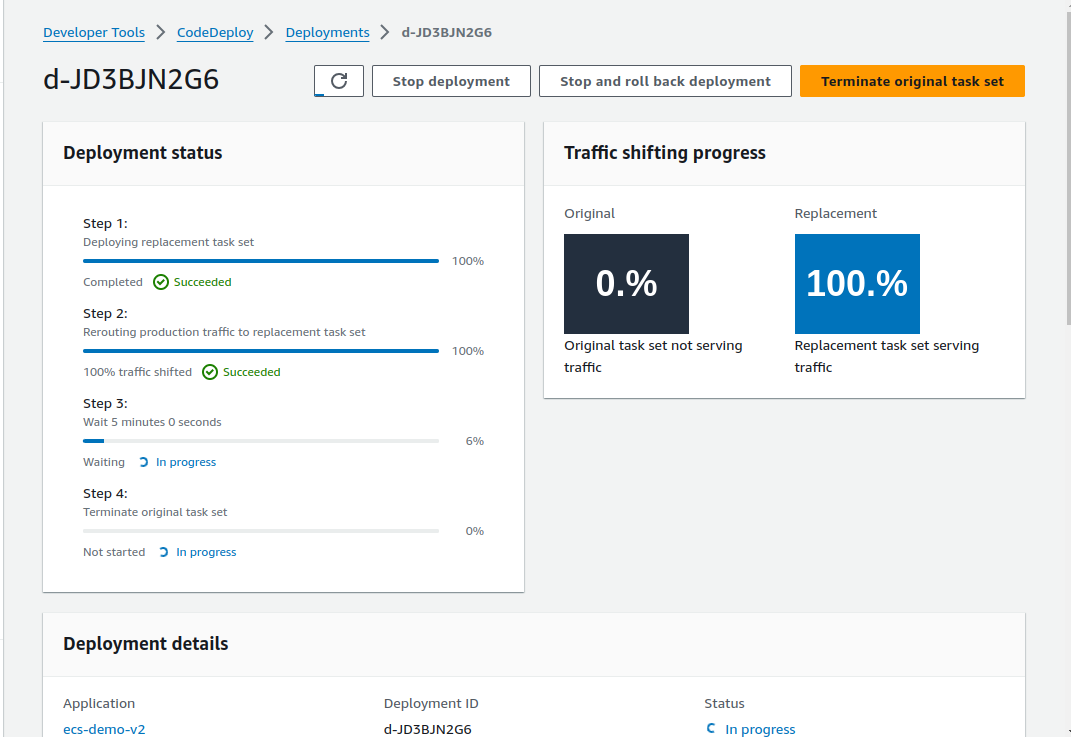

In the previous article, I described a process of using terraform to provision the infrastructure required to run an ECS service. However, updating the service via Terraform was not ideal even in a development environment. I managed to come up with a process that uses AWS Code Deploy and GitHub actions to coordinate the development and deployment of the service, to create a smoother process.
Firstly, I removed the terraform modules for the task definition and created it as a single file in the repository taskdef.json. This will become clear in a moment when I describe the github actions I used in the workflow. AWS recommendation is to add the task definition into version control as this would allow us to track the lineage of the automated deployment i.e. which task definition created this service.
Next, I created a simple workflow for deployment which has 2 distinct jobs: build and deploy. The build stage will build the application into a Docker container and push it with its git commit SHA as its tag onto ECR. It will update the task definition taskdef.json with the image attribute pointing to the pushed container.
To achieve this, we would require the following open-source aws actions to interact with ECR:
- aws-actions/amazon-ecr-login
- aws-actions/amazon-ecs-render-task-definition
The amazon-ecr-login action allows the assumed IAM role to login to a private ECR repo. Following a successful build and push, the amazon-ecs-render-task-definition updates the taskdef.json file dynamically with the new image URL and returns a new task definition json file. We can save and upload this new task defintion as an artifact of the build stage for consumption in the deploy stage.
The workflow for the build stage now looks like this:
permissions:
id-token: write
contents: read
jobs:
build:
name: Build Image
runs-on: ubuntu-latest
steps:
- uses: actions/checkout@v4
name: Checkout Repository
- uses: aws-actions/configure-aws-credentials@v4
with:
role-to-assume: $
role-session-name: GitHub-Action-Role
aws-region: $
- name: Login to Amazon ECR Private
id: login-ecr
uses: aws-actions/amazon-ecr-login@v2
- name: Build, tag, and push image to Amazon ECR
id: build-image
env:
ECR_REGISTRY: $
ECR_REPOSITORY: fastapi-dev
IMAGE_TAG: $
run: |
docker build -t $ECR_REGISTRY/$ECR_REPOSITORY:$IMAGE_TAG -f api_application/Dockerfile api_application
docker push $ECR_REGISTRY/$ECR_REPOSITORY:$IMAGE_TAG
echo "image=$ECR_REGISTRY/$ECR_REPOSITORY:$IMAGE_TAG" >> $GITHUB_OUTPUT
- name: Fill in the new image ID in the Amazon ECS task definition
id: task-def
uses: aws-actions/amazon-ecs-render-task-definition@v1
with:
task-definition: taskdef.json
container-name: fastapi
image: $
- name: Rename task definition
run: |
cp $ taskdef-new.json
cat taskdef-new.json
- name: Upload Task Definition
uses: actions/upload-artifact@v4
with:
name: taskdef
path: taskdef-new.jsonUnder the step task-def we create and return an updated task definition. We renamed it as the step output returned a random filename. We create an artifact of it and upload it as taskdef-new.json. By versioning the task definition file, the build stage is possible.
For using Code Deploy, I created additional terraform modules which created an application and a deployment group:
resource "aws_codedeploy_app" "example" {
compute_platform = "ECS"
name = "ecs-demo-v2"
}
resource "aws_codedeploy_deployment_group" "example" {
app_name = aws_codedeploy_app.example.name
deployment_config_name = "CodeDeployDefault.ECSAllAtOnce"
deployment_group_name = "ecs-demo-v2-dg"
service_role_arn = "DevCodeDeployECSRole"
auto_rollback_configuration {
enabled = true
events = ["DEPLOYMENT_FAILURE"]
}
blue_green_deployment_config {
deployment_ready_option {
action_on_timeout = "CONTINUE_DEPLOYMENT"
}
terminate_blue_instances_on_deployment_success {
action = "TERMINATE"
termination_wait_time_in_minutes = 5
}
}
deployment_style {
deployment_option = "WITH_TRAFFIC_CONTROL"
deployment_type = "BLUE_GREEN"
}
ecs_service {
cluster_name = aws_ecs_cluster.foo.name
service_name = aws_ecs_service.fastapi_service.name
}
load_balancer_info {
target_group_pair_info {
prod_traffic_route {
listener_arns = [aws_lb_listener.http.arn]
}
target_group {
name = aws_lb_target_group.service_targetgroup_green.name
}
target_group {
name = aws_lb_target_group.service_targetgroup_blue.name
}
}
}
}Within Code Deploy, every deployment belongs to a deployment group, which in turn belongs to an application. We create the application first using a aws_codedeploy_app resource. Next, we create it’s associated deployment group using aws_codedeploy_deployment_group. It requires an IAM role with at least the AWSCodeDeployRoleForECS policy. You would need to add additional policies for S3 access if you are providing the appspec.json file via S3.
By default, Code Deploy uses Blue-Green deployment for ECS services. This means we need to create an additional target group but we don’t add this to the listener provisioned.
Code Deploy will automatically:
- Create a replacement task set for the ECS service
- Register the new task to the second target group
- Deassociate the current target group from the ALB
- Associate the second target group to the ALB.
This is specified in the blue_green_deployment_config above.
The above can be replaced with an on-premise deployment strategy which links the Github repo via a Github token to the deployment group but it seems to require a running Code Deploy agent and only works for EC2 / on-prem instances. Future articles will explore how this setup works.
The appspec.json file is required for any Code Deploy deployment so it must be created and checked into version control. The basic structure is as so:
{
"version": 0.0,
"Resources": [
{
"TargetService": {
"Type": "AWS::ECS::Service",
"Properties": {
"TaskDefinition": "<TASK_DEFINITION>",
"LoadBalancerInfo": {
"ContainerName": "fastapi",
"ContainerPort": 9000
}
}
}
}
]
}The Task definition attribute is set to a placeholder which will be replaced in the deploy stage.
The deploy job in the workflow is as follows:
deploy:
name: Deploy
runs-on: ubuntu-latest
needs: build
steps:
- uses: actions/checkout@v4
name: Checkout Repository
- name: Download Task Definition
uses: actions/download-artifact@v4
with:
name: taskdef
path: taskdef
- uses: aws-actions/configure-aws-credentials@v4
with:
role-to-assume: $
role-session-name: GitHub-Action-Role
aws-region: $
- name: Deploy to Amazon ECS
uses: aws-actions/amazon-ecs-deploy-task-definition@v1
with:
task-definition: taskdef/taskdef-new.json
service: fastapi-service
cluster: MyCluster
wait-for-service-stability: true
codedeploy-appspec: appspec.json
codedeploy-application: ecs-demo-v2
codedeploy-deployment-group: ecs-demo-v2-dgWe utilize the amazon-ecs-deploy-task-definition action provided by AWS. It takes as input the updated task defintion file from the build stage, which has now been downloaded and extracted into the working directory. It registers this task definition file provided as a new version under ECS.
The last three lines define the parameters of triggering a code deploy job. It requires the application and deployment group names. It also takes in the appspec.json file and replaces the task defintion placeholder with the newly registered task definition ARN from above. We set the job to wait until the service is successfully deployed but it’s not necessary as we can check the deployment job status in the console UI.
Once deployed, we can access the service with the latest changes via ALB.
Further examples and usage of the Github Actions can be found at the following links: AWS ECR Login, AWS ECS DEPLOY TASK DEFINITION, AWS ECS RENDER TASK DEFINITION.
Screenshots below show Code Deploy making a successful deployment and the call logs from Github Actions:


The code base will be open source once refactoring is completed.
H4PPY H4CK1NG !